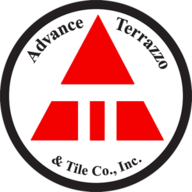FAQs
Advance Terrazzo & Tile
Have a flooring-related question? We have the answer. Check out these FAQs and give us a call today for more information!
What is terrazzo made of?
Terrazzo consists of a combination of marble chips, glass, granite, or other aggregates embedded in a cement or resin binder. This composition results in a durable and aesthetically pleasing surface.Is terrazzo suitable for outdoor use?
Terrazzo can be utilized outdoors, however, it is more appropriate for southern climates such as Florida, Arizona, or California. The freeze/thaw cycle and accumulation of ice and snow in colder regions can create slippery conditions, making it less suitable for exterior applications in these areas.How do I maintain terrazzo?
Proper terrazzo maintenance involves regular sweeping or vacuuming, mopping with a pH-neutral cleaner, and periodic resealing to preserve the surface's protective layer and maintain its lustrous appearance.Can terrazzo be installed over existing flooring?
Terrazzo installation over existing flooring is possible, provided that appropriate subfloor preparation and leveling procedures are carried out to ensure a successful application.Is terrazzo eco-friendly?
Terrazzo can be considered an environmentally responsible choice when manufactured using recycled materials and low-VOC binders. Its long-lasting nature also contributes to its overall sustainability.How much does terrazzo cost?
Terrazzo pricing varies depending on materials, design complexity, and installation requirements. For commercial flooring, costs typically range from $27 to $33 per square foot, with custom designs commanding higher prices.Is terrazzo slippery when wet?
Terrazzo surfaces, particularly those with a high-gloss finish, can become slippery when wet. To mitigate this risk, textured finishes or slip-resistant treatments may be applied to enhance traction.Can I customize terrazzo?
Terrazzo offers extensive design flexibility, allowing for customization in colors, patterns, and aggregate selections to suit individual preferences and project requirements.What are the benefits of terrazzo?
Terrazzo flooring provides numerous advantages, including durability, low maintenance requirements, design versatility, and resistance to moisture, stains, and surface abrasions.How is terrazzo installed?
The terrazzo installation process involves pouring, leveling, grinding, and polishing the mixture on a properly prepared subfloor. Due to the complexity of this procedure, professional installation is strongly recommended.
Learn More About
Advance Terrazzo & Tile
Located in Coon Rapids, MN. Advance Terrazzo & Tile specializes in terrazzo and ceramic tile installation. 1-year labor and material warranty. Over 100 years of combined experience. Quality workmanship. Request a free quote today.
serving Area
Minnesota
North Dakota
South Dakota
Iowa
Wisconsin
Business Hours
- Mon - Fri
- -
- Sat - Sun
- Closed
Hi. Do you need any help?
Privacy Policy
| Do Not Share My Information
| Conditions of Use
| Notice and Take Down Policy
| Website Accessibility Policy
© 2025
The content on this website is owned by us and our licensors. Do not copy any content (including images) without our consent.

Share On: